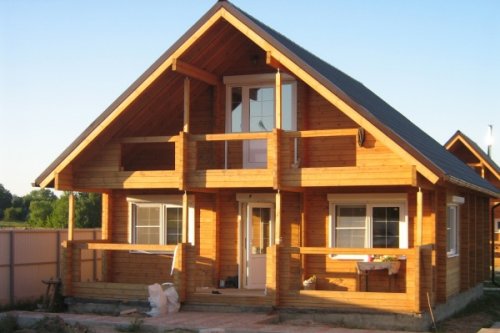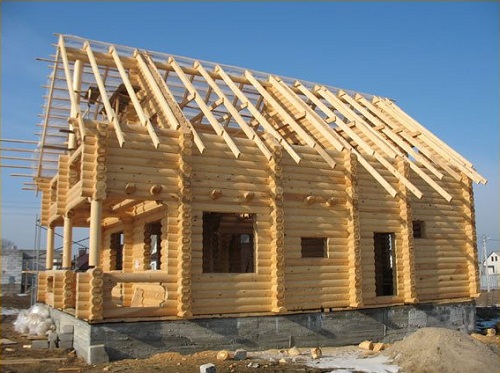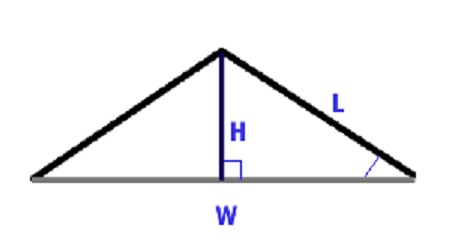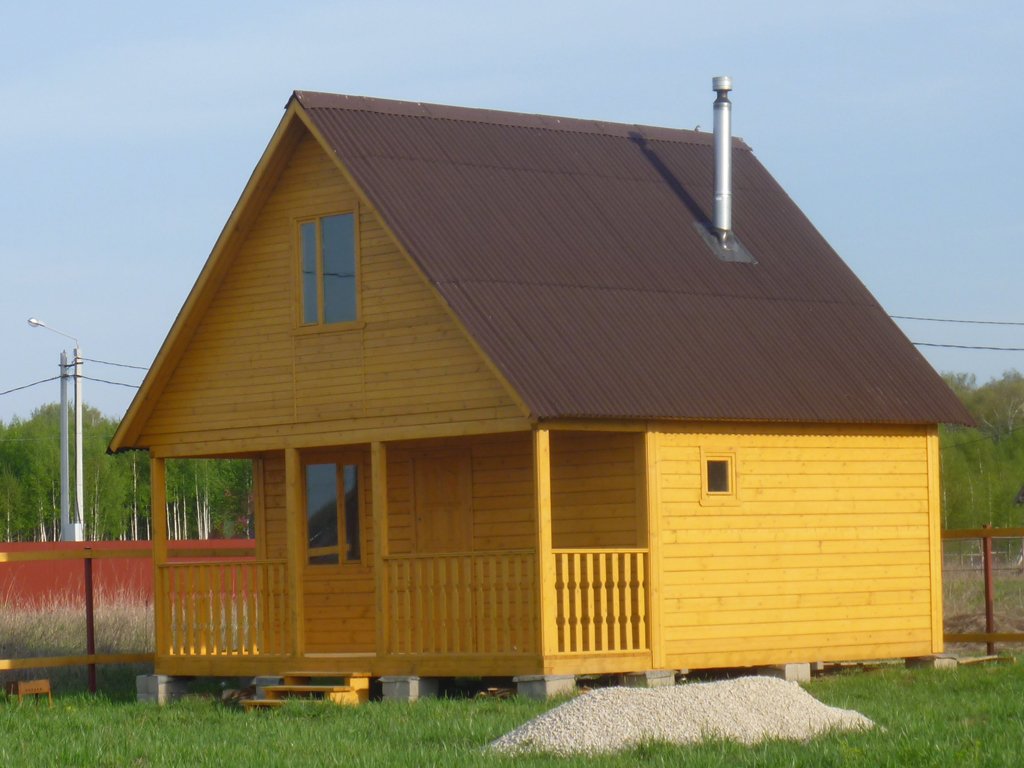The most important part of the construction of any building with a gable roof device is the rafter system and the Mauerlat. Given the location of these particular structures, the calculation of the roof of a gable roof is performed.

A gable roof is the simplest type of roof. Both surfaces of the roof are at a certain slope with respect to the outer walls of the building. Thanks to this, it becomes possible to ensure a natural runoff of thawed snow and rainwater. The slope of the gable roof must exceed 5 °. In addition, in some parts of the roof, it may well exceed 60 °, and even reach 90 °.
The angle of inclination of the roof slopes depends on that. What roofing material was chosen, as well as from architectural decisions and climatic conditions of a particular region. In cases where loose roofing materials are used, steeper pitched surfaces are installed. It is also necessary in regions that are characterized by a large amount of rainfall. A gently sloping roof with a slope of less than 10 ° is mounted when weather conditions in the region are characterized by low rainfall and strong winds. Due to the small angle of inclination, it is possible to reduce the load and pressure on the roof truss structure.
More time consuming and requiring certain monetary costs, is the device Mauerlat. However, saving in this case is not worth it. It is necessary to carefully and accurately calculate the most optimal angle of inclination of the roof. Indeed, this ensures the reliability and strength of the entire structure. In accordance with all kinds of norms and rules of technical and operational safety.
In private and suburban construction, a gable roof is considered the most optimal option. Thanks to a rather simple, uncomplicated form of construction, the gable roof is erected without any difficulties and quite quickly. In addition, in the case when the budget is limited, it is quite possible to independently erect a roof, without involving specialists. Simply put, you can mount a gable roof with your own hands. To do this, you only need to have basic knowledge of construction.
The standard gable roof of the house consists of two planes called ramps. They are tilted to the outside of the walls of the building. The gable roof system also includes triangular lateral elements called pediments. This version of the roof is usually erected on buildings with low floors.
Also, the design of the roof with two slopes suggests the presence of enclosing and supporting elements, such as: roofing, rafter system, Mauerlat.
Please note that in addition to the main elements in the construction of a gable roof, there are many additional ones. These are racks, crossbars, struts, struts and other fasteners. It is with their help that they betray the rafter system with additional strength and rigidity.
Bearing structural elements take on the bulk of the various weather conditions. Caught on the building, as well as a lot of roofing system. Bearing elements, or rather rafter legs and Mauerlat. Distribute the weight on the walls and supports of the building. These elements should be subject to the most stringent requirements of rigidity and strength. Thus, Mauerlat and rafters are the main supporting elements of the roof structure. The calculation of their location and the choice of material should be approached especially responsibly.
Content
Mauerlat - basic parameters

Mauerlat can be called the foundation of the roof of the house. It is a beam, which serves as the basis for the installation of supporting rafters. Its main function is the load distribution, which is created by the roof of the house. Mauerlat is a structural element of the roof in the form of a solid beam, the cross section of which is approximately 10 by 10 or 15 by 15 cm.
The Mauerlat system is laid along the perimeter of the building, under the rafter leg. The bars are fixed using self-tapping screws and wire, which is mounted on the wall at the stage of brickwork. Depending on the structural features of the walls and roof of the house, the Mauerlat can be mounted either axially or closer to the edge of the wall. It does not matter, either externally or internally, but most importantly, that would be at least 6 cm from the edge of the outer edge.
As a rule, in the manufacture of Mauerlat wood is used. However, in the event that the rafter system is constructed from a metal frame, it is possible to use double-tee, channel and other metal-profile Mauerlates of similar origin. But even metal-profile structures require reliable and durable fastening to the walls of the building.
A layer of waterproofing material, for example, roofing material, is laid under the Mauerlat. The distance between the layers should be about 40 cm, counting from the very top of the attic floor. At the same time, the runs should rest on racks cut into the beds. The interval between them should be from 3 to 5 meters.
Please note that the angle between the strut and the rafter foot must be brought as close as possible to 90 °. And also, the support struts, which are installed for additional rigidity of the roof frame with too long rafters, should be placed abutting in the bed.
Thus, Mauerlat is a system of links that are firmly connected to each other. They are attached to the rafters, thereby creating a stable and reliable pitched structure around the entire perimeter of the roof. In addition, the Mauerlat can also be attached to the rafters in separate segments.
We draw your attention to the fact that in the case when not too wide rafters are used, this can lead to sagging of the structure. A pretty serious risk of danger. In order to prevent this threat, we recommend using a special grille to strengthen the structure. The grill consists of a crossbar, struts and a rack. To create it, boards are used, the thickness of which can vary from 2.5 to 15 cm, depending on the thinness of the rafter legs. Also, for the manufacture of gratings, it is possible to use plates of logs, the diameter of which is at least 13 cm.
Rafter system - knot sizes

The roof rafter system is a supporting structure consisting of the rafters themselves, vertical racks and inclined struts. Rafters are connected to the system using various elements: crossbars, struts, struts, struts. The rafter system can be built from any material: metal, reinforced concrete, wood and others.
At the heart of the design of the entire roof truss system with two slopes is a triangle. The bottom line is that it is the triangle that is the most stable and rigid geometric figure.
For rafters, the recommended cross-section of the beam varies from 4 to 15 cm to 10 to 25 cm. This indicator directly depends on the pitch of the installed rafters, the length of the rafter legs, as well as the magnitude of wind and snow loads calculated for a particular region.
Recommended section of the beam used for the roof truss system with two slopes.
All values are given in centimeters.
Mauerlat: 10x10, 10x15, 15x15.
Ends and diagonal legs: 10x20.
Runs: 5x15.
Racks: 10x10, 15x15.
Basic crossbars for strengthening of racks: 10х15, 10х20.
Boards of cornice box, struts, filly: 5x15.
Hemming and frontal boards: 15x25.
Puffs: 5x15.
The angle of the rafters is equal to the required angle of inclination of the roof slopes. The rafter in cross section must be at least 5 cm. The width depends on the length. So, for example, if the length of the board used is 6 m, then its width should be 15 cm. Accordingly, the longer the board, the greater the width must be chosen.
The connection of all structural elements of the rafter system is the final stage of installation. For this, staples or metal corners are used. It is not difficult to calculate the required amount of these elements. It is enough to calculate how many total elements are in the structure, and multiply the resulting number by the number of necessary fixtures for one element.
How to calculate gable roof height

This is easy enough to do. Knowing the angle of the rafter system or the length of the ramp, as well as the distance between the lower edge of the rafter leg and the perpendicular dropped from the middle of the proposed ridge (usually this place is the center of the house) using simple geometric rules of calculation or Pythagoras theorem.
To summarize, the entire calculation of the roof can be reduced to the following provisions:
The weight of the structure, rainwater and snow cover must be taken into account.
If in the future it is supposed to replace the roof with a heavier one, the strength of the rafter system should be calculated in advance.
You should seriously consider the choice of material for the manufacture of the rafter system. All parameters: board width and strength should be considered.
The gable roof should be calculated in accordance with generally recognized parameters for each structural element.





Alas, no comments yet. Be the first!